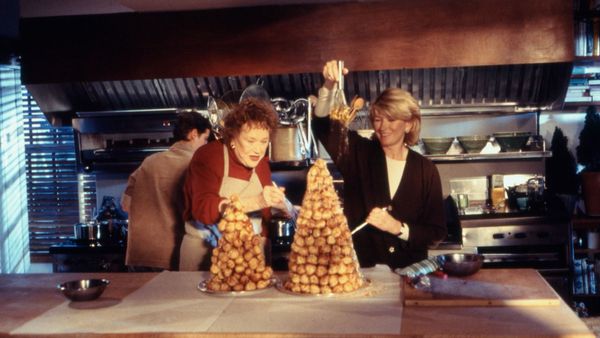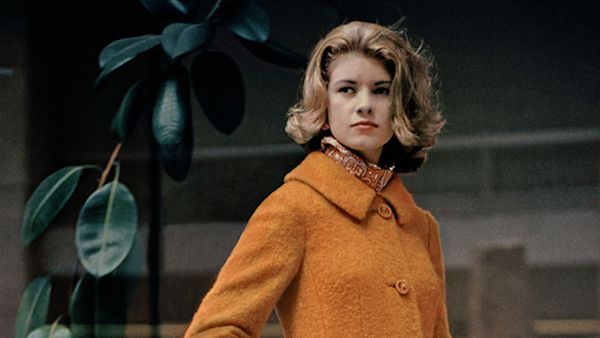In the late ‘90s, when Martha Stewart was at the peak of her powers, submitting her to stress tests to find her flaws and vulnerabilities became a top hobby among reporters and other interviewers.
Despite hosting a daytime series defined by its serene gentility, distinguishing itself from the screaming talk shows airing in other slots, the public became convinced that Stewart, a driven perfectionist, was not altogether human.
That makes an uncharacteristically candid moment in the third episode of CNN’s “The Many Lives of Martha Stewart” one of the few truly illuminating glimpses into who she really is – not a monster, a diva or any of the other labels pressed onto her with the hot glue of public disdain. Instead, at the end of a how-to segment on covering a chair seat, she gives us a glimpse of her unguarded self.
Stewart is trimming the upholstery material's edge when a producer says, “We’re done,” but she doesn’t stop cutting. “Alright, can I just say something to everybody?” she asks calmly, never looking up from guiding her scissors in a straight line. “I'm very grateful for all of you for sticking by and living through my personal horrible nightmare . . . I mean, I have not been accused of one f**king thing, OK?”
She continues to perfect her effort as she confesses she’s been through “nine months of the worst imaginable torture,” describing the feeding frenzy resulting from her link to the ImClone Systems stock trading case. “I have never kept my mouth shut, ever, in my life and this is the first time I've ever done it. And it's very hard not to go on Larry King tonight. I'll tell you.”
Then she puts down the scissors and picks up a staple gun. “So thank you,” she continues calmly as the staples loudly bang into the wood, “and I hope that you all think good thoughts, and we get through all of this. They seem hell-bent on destroying me for whatever reason. And it's very, very unfair.”
Reading this probably elicits little in the way of sympathy for Stewart, especially the Larry King part. But at that time Stewart’s name, reputation, and image were subjected to endless attacks in the news and jokey late-night monologues, none of which she responded to.
Instead, she continued to publish her magazine Martha Stewart Living and producing her popular TV show. She stayed on task.
 The Many Lives of Martha Stewart (CNN)If you are a woman or were raised by a woman like Martha Stewart – that is, someone who holds that nothing is achieved without hard work and who was schooled in the art of swallowing tears and outrage – then you may recognize this moment's significance. This is Martha Stewart admitting to the world that she feels like she’s breaking but knows she’d better not, that her legs are shuddering under the load that was steadily growing heavier for years before the deriders started jumping on it.
The Many Lives of Martha Stewart (CNN)If you are a woman or were raised by a woman like Martha Stewart – that is, someone who holds that nothing is achieved without hard work and who was schooled in the art of swallowing tears and outrage – then you may recognize this moment's significance. This is Martha Stewart admitting to the world that she feels like she’s breaking but knows she’d better not, that her legs are shuddering under the load that was steadily growing heavier for years before the deriders started jumping on it.
Its approach is evenhanded and cautiously admiring to the point of pedestrian flatness.
The same woman who showed up to work at CBS shortly after her name was associated with that of ImClone founder Sam Waksal, who would eventually be convicted on multiple charges related to the case. Stewart steadily refused to answer a network anchor’s question about it, repeating that she was just there to make salad. Which she did.
Enough time appears to have passed between that epic TV showdown and this chair-covering outtake for Stewart to joke about her staple gun fixation by saying, “I'm chopping cabbage.” Everybody laughs, including Stewart, who continues stapling until the chair seat's ugliness is snugly disguised.
“Martha Stewart Living” kept going too until Stewart was found guilty of obstructing justice and lying to investigators, eventually serving five months in prison and losing most of her billion-dollar empire in the process.
Provided you lived through several, if not all, of her various incarnations, “The Many Lives of Martha Stewart” isn’t going to tell you much you don’t already know or want to know. If your familiarity with Martha Stewart is limited to her Snoop Dogg’s GirlBoss bestie era, or you mainly know her as that octogenarian posting thirst traps on social media before becoming the oldest Sports Illustrated model, you may learn quite a bit.
But that age group probably isn’t watching CNN docuseries. The target audience of “Many Lives” probably found Stewart in her “Entertaining” era, when she had remade herself from a hotshot stockbroker into the next Julia Child, or fell for "Living" on TV, with its gentle acoustic guitar theme. When she became the Godmother of Food Porn. If that describes you, little in these four episodes is surprising.
Indeed, the paucity of analytical insight concerning the media’s digestion of Stewart's rise and fall is confounding. Stewart’s tar-and-feathering is a rich area of study for academics and writers; nearly every intensely covered downfall of an influential woman can draw parallels to her humiliation. This damning stat cited in a 2019 Longreads essay tells a compelling tale by itself: Between November 2003 and May 2004, the time period of Stewart’s trial that coincided with the feds' investigation of Enron CEO Kenneth Lay, New York–based magazines featured Stewart in 1,507 articles. Lay starred in just 12.
Stewart was in her early 60s when she went to prison – not merely a successful woman laid low (by none other than James Comey, who was the United States attorney for the Southern District of New York at the time) but an older one too.
We need your help to stay independent
Neither Stewart, her ex-husband Andy, nor others closest to her participated in the series. But “The Many Lives of Martha Stewart” includes enough of a praiseworthy viewpoint for the audience to recognize the double standard to which she was subjected in her public life. She spent years enduring questions about her choice to stay single after her divorce or why she thought people couldn’t stand her.
Overall, though, its approach is evenhanded and cautiously admiring to the point of pedestrian flatness.
Stewart isn’t merely noteworthy for her astronomical rise, grave fall from grace, and phoenix-like ascent afterward. She’s someone who plugs into our culture's diametric emotions related to homemaking and feminism. The witnesses to Stewart’s early life and career are intriguing, especially a pair of stockbrokers responsible for hiring her into what was then an all-boys club; one of them was obviously attracted to her legs more than her brain and was blown away when she proved to be one of the best brokers at their firm.
 The Many Lives of Martha Stewart (CNN)
The Many Lives of Martha Stewart (CNN)
I appreciate the way Stewart uplifted the feminist value of homemakers, reminding the world that nobody is “just” a housewife.
From there the voices become a typical assemblage, including former employees of Stewart’s early catering business who recall those times with a mixture of smiles and bitterness. “What you should ask me is when I chose to leave Martha. OK?” says Sarah Gross, a member of Stewart’s catering staff in her life before publishing her first bestselling cookbook. “So I’m going talk about that.”
Gross does, sharing a story summed up in vaguely admiring terms that are also condemnatory. “That’s Martha: She had a vision of where she wanted to go, and nothing and nobody was going to get in her way.”
Blending these chunks into a mixture of respectful voices such as chefs David Chang and Carla Hall, culinary author Claire Saffitz, and former NPR host Audie Cornish, provides enough contrast to hold our attention.
The series also heavily leans on the voice of CNN contributor Jeffrey Toobin, who had his own fall from grace when he masturbated himself out of a longtime staff position at The New Yorker. So.
A melodic score bouncing between genteel and bright and frenetic and discordant is a thumb on the scales as if the producers want to remind us that the glorious, homespun tableaus filling our TV screens are the product of a crazed taskmistress. There's more than enough said without that to allow the audience to draw their own conclusions.
I count myself as a Martha Stewart admirer if not an utter devotee. I respect her innovation, drive, thirst for knowledge and insistent standards. I use her recipes and learn from her techniques . . . and yet would never, ever work for her.
Want a daily wrap-up of all the news and commentary Salon has to offer? Subscribe to our morning newsletter, Crash Course.
Nevertheless, I appreciate the way Stewart uplifted the feminist value of homemaking, reminding the world that nobody is “just” a housewife.
 The Many Lives of Martha Stewart (CNN)She also bolstered the "women having it all" myth by insisting that we're obligated to excel in both our careers and the home, making herself the example. She did this without admitting that she can run on three hours of sleep and launched her lucrative empire with money earned from her extremely well-paying Wall Street gig. Part of the founding legend was that her white-collar job consumed all her energy and made her miss spending time with her family. A short time after she left that world, she was so busy turning D.I.Y. homemaking into a multimillion dollar business that, as her daughter Alexis famously told Larry King, she commemorated her daughter's birthday one year with a pound cake with no frosting and one big candle in the middle.
The Many Lives of Martha Stewart (CNN)She also bolstered the "women having it all" myth by insisting that we're obligated to excel in both our careers and the home, making herself the example. She did this without admitting that she can run on three hours of sleep and launched her lucrative empire with money earned from her extremely well-paying Wall Street gig. Part of the founding legend was that her white-collar job consumed all her energy and made her miss spending time with her family. A short time after she left that world, she was so busy turning D.I.Y. homemaking into a multimillion dollar business that, as her daughter Alexis famously told Larry King, she commemorated her daughter's birthday one year with a pound cake with no frosting and one big candle in the middle.
“The Martha Stewart story is very much about having no limits,” a subject says. But it has plenty of bumps and warts beyond the obvious that add to Stewart’s story and brand in fascinating ways, and a more thorough and provocative examination of those might have been the flavoring that could have elevated this series from fine to a really good thing.
The first two episodes of "The Many Lives of Martha Stewart" are available on demand to pay TV subscribers via CNN.com, and CNN connected TV and mobile apps starting on Monday, Jan. 29. The series concludes with two episodes airing at 9 p.m. Sunday, Feb. 4 on CNN.
Read more
about this topic



Shares